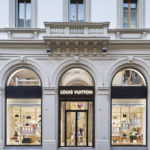LVMH thinks the luxury downturn is a blip, can it be so sure?

You can’t have it all, just ask the other 99%. Walk through Soho on a weeknight and behind the chic bistro curtains, the restaurants are full, and, as we all know, they haven’t got any cheaper. Scroll through Instagram and the endless pictures of white beaches and sunshine selfies give the impression that everybody is always on holiday, bar you.
All of these things have become more expensive, and something has to give. People’s priorities have changed. Looking at the figures from LVMH’s Q3 results, it appears ‘luxury’ fashion has been the sacrifice. Today’s aspirational consumer can’t eat in expensive restaurants, jet off on holiday multiple times a year AND wear expensive clothes anymore. They have voted with their previously designer shod feet, and opted for experiences against a background of rising mortgages and designer prices.
Buying designer pieces just isn’t worth it anymore. The prices are, according to HSBC, on average, 54% higher than before Covid. Many ‘iconic’ items have even doubled in price since 2019 and it has turned off a lot of consumers. The question is, what will win them back?
The world’s largest and most watched luxury group, LVMH, owner of Louis Vuitton, Dior and Givenchy, recently reported a 5% drop in its fashion and leather goods segment in Q3, missing analysts’ expectations of 0%-2% growth. The stock fell 7% on the Paris stock market.
The luxury group is being positive and banking on a blip, blaming problems in Asia, most specifically China. Sales fell a hefty 16% there. The recent Asian engine of Japan, driven by tourism, saw growth slowing. The rest of the world was flat.
But, how can they be so sure this is just a blip? Many Linked In luxury commentators are saying it’s the downward stage of a traditional luxury cycle, but it feels different this time. Some luxury brands have taken consumers for granted, which many in the industry have mentioned before, and it finally feels like consumers have woken up.
This hasn’t happened overnight. This has been years in the making, way before the pandemic. LVMH developed the dangerous attitude of feeling it was unstoppable and consumers were just numbers blindly buying expensive things with recognisable names on.
When a designer T-shirt has become the same price as a flight to South Korea, consumers who would once splurge on the odd luxury item have been put off, especially when that T-shirt doesn’t seem any better quality in terms of design and make than what else is available out there at a fraction of the price.
These luxury groups give the impression they speak to the 1%, which they do, but they also need the rest of us to make up the numbers. With sales of nearly €80 billion a year, thanks to its 75 ‘Maisons’ with more than 6,000 stores and 200,000-plus employees, it is a beast and needs regular people buying entry products to hit those numbers. It needs those people who would once spend a month’s wages on a coveted item.
Dior AW24 womenswear (Vianney Le Caer/AP)
Consumers don’t believe they are buying the best anymore. The sense of trust has been lost between luxury brands and consumers. Stories about extortionate margins and dodgy supply chains have added fuel to the negativity. And it doesn’t help that many of the clothes are ugly, particularly, in my views, Louis Vuitton and Dior womenswear.
Luxury brands have become too reliant on big name creative directors who stay for a few years and move on. Having super designers that brands hold up on a pedestal one minute, then drop the next, changing the direction of the house in the process, is a mistake for a luxury brand. These sorts of heritage brands need longevity of vision and consumers should be buying into something long term, not just for a few seasons because a designer is particularly hot right now. Hermès is the perfect example of a successful brand that has swerved this business model.
When brands are not seen to do doing anything worthy of people’s money, consumers will spend the cash on other things which they feel offers better value in their lives. There is also an underlining trend of people consciously buying less stuff or opting for secondhand, regardless of incomes (indeed a key driver of the secondary luxury market is from high-spending consumers looking for items that were far better produced in the past).
LVMH and others need to look at their long-term strategy and show consumers they are offering value regardless of the price points. To win back consumers, it will require quality and innovative design. For companies run by accountants, they will need to start by educating themselves in the product first. When the momentum swings downwards and consumers have decided they are ‘out’, blips are very hard to recover from.








